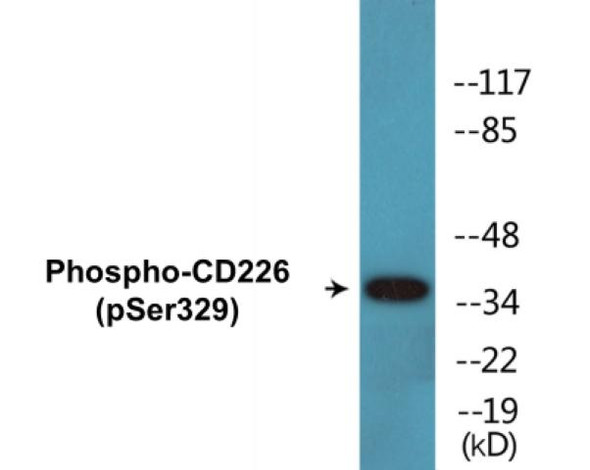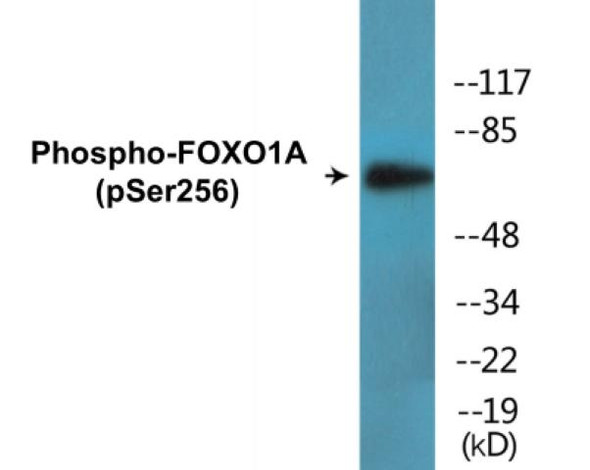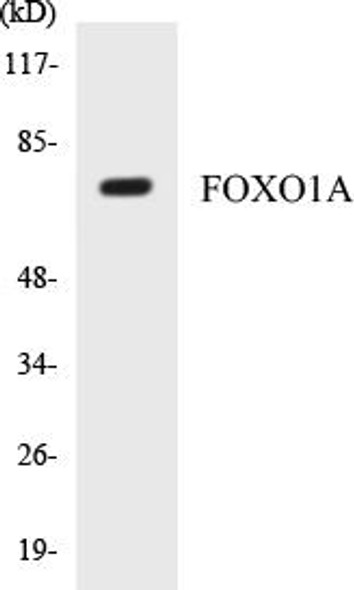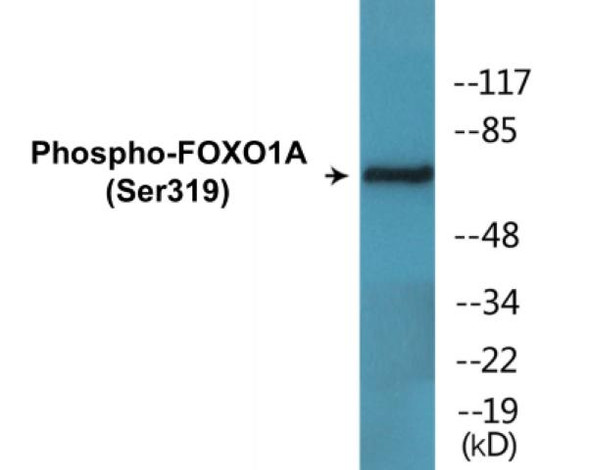Description
FOXO1A (Phospho-Ser329)Colorimetric Cell-Based ELISA Kit
The FOXO1a Phospho-Ser329 Colorimetric Cell-Based ELISA Kit is a cutting-edge assay designed for the quantitative detection of phosphorylated FOXO1a protein levels in cell lysates. This kit offers high sensitivity and specificity, ensuring accurate and reliable results for a variety of research applications.FOXO1a is a key transcription factor involved in regulating cell growth, metabolism, and apoptosis. Phosphorylation of FOXO1a at Ser329 plays a critical role in its activity and function, making it a valuable biomarker for studying signal transduction pathways and cellular processes.
By using the FOXO1a Phospho-Ser329 Colorimetric Cell-Based ELISA Kit, researchers can gain valuable insights into the regulation of FOXO1a phosphorylation and its impact on cell signaling pathways. This kit is ideal for studying diseases such as cancer, diabetes, and cardiovascular disorders, where dysregulation of FOXO1a phosphorylation is implicated.
| Product Name: | FOXO1A (Phospho-Ser329) Colorimetric Cell-Based ELISA |
| Product Code: | CBCAB00418 |
| ELISA Type: | Cell-Based |
| Target: | FOXO1A (Phospho-Ser329) |
| Reactivity: | Human, Mouse, Rat |
| Dynamic Range: | > 5000 Cells |
| Detection Method: | Colorimetric 450 nm |
| Format: | 2 x 96-Well Microplates |
The FOXO1A (Phospho-Ser329) Colorimetric Cell-Based ELISA Kit is a convenient, lysate-free, high throughput and sensitive assay kit that can detect FOXO1A protein phosphorylation and expression profile in cells. The kit can be used for measuring the relative amounts of phosphorylated FOXO1A in cultured cells as well as screening for the effects that various treatments, inhibitors (ie. siRNA or chemicals), or activators have on FOXO1A phosphorylation.
Qualitative determination of FOXO1A (Phospho-Ser329) concentration is achieved by an indirect ELISA format. In essence, FOXO1A (Phospho-Ser329) is captured by FOXO1A (Phospho-Ser329)-specific primary antibodies while the HRP-conjugated secondary antibodies bind the Fc region of the primary antibody. Through this binding, the HRP enzyme conjugated to the secondary antibody can catalyze a colorimetric reaction upon substrate addition. Due to the qualitative nature of the Cell-Based ELISA, multiple normalization methods are needed:
| 1. | A monoclonal antibody specific for human GAPDH is included to serve as an internal positive control in normalizing the target absorbance values. |
| 2. | Following the colorimetric measurement of HRP activity via substrate addition, the Crystal Violet whole-cell staining method may be used to determine cell density. After staining, the results can be analysed by normalizing the absorbance values to cell amounts, by which the plating difference can be adjusted. |
| Database Information: | Gene ID: 2308, UniProt ID: Q12778, OMIM: 136533/268220, Unigene: Hs.370666 |
| Gene Symbol: | FOXO1 |
| Sub Type: | Phospho |
| UniProt Protein Function: | FOXO1A: a transcription factor of the forkhead family. A central regulator of metabolism in several cell types. May play an important role in myogenic growth and differentiation, and in the regulation of lipolysis in adipocytes by controlling the expression of adipose triglyceride lipase (ATGL), the rate-limiting lipolytic enzyme. Translocation of this gene with PAX3 has been associated with alveolar rhabdomyosarcoma. Contains 1 fork-head domain. |
| UniProt Protein Details: | Protein type:Nuclear receptor co-regulator; Oncoprotein; DNA-binding; Transcription factor Chromosomal Location of Human Ortholog: 13q14.1 Cellular Component: cytoplasm; cytosol; mitochondrion; nucleoplasm; nucleus Molecular Function:beta-catenin binding; chromatin binding; protein binding; protein phosphatase 2A binding; sequence-specific DNA binding; ubiquitin protein ligase binding Biological Process: anatomical structure morphogenesis; apoptosis; autophagy; blood vessel development; cell differentiation; cell glucose homeostasis; cellular response to insulin stimulus; cellular response to starvation; endocrine pancreas development; epidermal growth factor receptor signaling pathway; fat cell differentiation; fibroblast growth factor receptor signaling pathway; innate immune response; insulin receptor signaling pathway; negative regulation of apoptosis; negative regulation of fat cell differentiation; negative regulation of stress-activated MAPK cascade; negative regulation of transcription from RNA polymerase II promoter; negative regulation of transcription, DNA-dependent; nerve growth factor receptor signaling pathway; phosphoinositide-mediated signaling; positive regulation of apoptosis; positive regulation of autophagy; positive regulation of gluconeogenesis; positive regulation of protein catabolic process; positive regulation of transcription from RNA polymerase II promoter; positive regulation of transcription, DNA-dependent; protein amino acid acetylation; response to DNA damage stimulus; thermoregulation; transcription, DNA-dependent Disease: Rhabdomyosarcoma 2 |
| NCBI Summary: | This gene belongs to the forkhead family of transcription factors which are characterized by a distinct forkhead domain. The specific function of this gene has not yet been determined; however, it may play a role in myogenic growth and differentiation. Translocation of this gene with PAX3 has been associated with alveolar rhabdomyosarcoma. [provided by RefSeq, Jul 2008] |
| UniProt Code: | Q12778 |
| NCBI GenInfo Identifier: | 116241368 |
| NCBI Gene ID: | 2308 |
| NCBI Accession: | Q12778.2 |
| UniProt Secondary Accession: | Q12778,O43523, Q5VYC7, Q6NSK6, |
| UniProt Related Accession: | Q12778 |
| Molecular Weight: | |
| NCBI Full Name: | Forkhead box protein O1 |
| NCBI Synonym Full Names: | forkhead box O1 |
| NCBI Official Symbol: | FOXO1 |
| NCBI Official Synonym Symbols: | FKH1; FKHR; FOXO1A |
| NCBI Protein Information: | forkhead box protein O1 |
| UniProt Protein Name: | Forkhead box protein O1 |
| UniProt Synonym Protein Names: | Forkhead box protein O1A; Forkhead in rhabdomyosarcoma |
| Protein Family: | Foxo1-corepressor |
| UniProt Gene Name: | FOXO1 |
| UniProt Entry Name: | FOXO1_HUMAN |
| Component | Quantity |
| 96-Well Cell Culture Clear-Bottom Microplate | 2 plates |
| 10X TBS | 24 mL |
| Quenching Buffer | 24 mL |
| Blocking Buffer | 50 mL |
| 15X Wash Buffer | 50 mL |
| Primary Antibody Diluent | 12 mL |
| 100x Anti-Phospho Target Antibody | 60 µL |
| 100x Anti-Target Antibody | 60 µL |
| Anti-GAPDH Antibody | 60 µL |
| HRP-Conjugated Anti-Rabbit IgG Antibody | 12 mL |
| HRP-Conjugated Anti-Mouse IgG Antibody | 12 mL |
| SDS Solution | 12 mL |
| Stop Solution | 24 mL |
| Ready-to-Use Substrate | 12 mL |
| Crystal Violet Solution | 12 mL |
| Adhesive Plate Seals | 2 seals |
The following materials and/or equipment are NOT provided in this kit but are necessary to successfully conduct the experiment:
- Microplate reader able to measure absorbance at 450 nm and/or 595 nm for Crystal Violet Cell Staining (Optional)
- Micropipettes with capability of measuring volumes ranging from 1 µL to 1 ml
- 37% formaldehyde (Sigma Cat# F-8775) or formaldehyde from other sources
- Squirt bottle, manifold dispenser, multichannel pipette reservoir or automated microplate washer
- Graph paper or computer software capable of generating or displaying logarithmic functions
- Absorbent papers or vacuum aspirator
- Test tubes or microfuge tubes capable of storing ≥1 ml
- Poly-L-Lysine (Sigma Cat# P4832 for suspension cells)
- Orbital shaker (optional)
- Deionized or sterile water
*Note: Protocols are specific to each batch/lot. For the correct instructions please follow the protocol included in your kit.
| Step | Procedure |
| 1. | Seed 200 µL of 20,000 adherent cells in culture medium in each well of a 96-well plate. The plates included in the kit are sterile and treated for cell culture. For suspension cells and loosely attached cells, coat the plates with 100 µL of 10 µg/ml Poly-L-Lysine (not included) to each well of a 96-well plate for 30 minutes at 37°C prior to adding cells. |
| 2. | Incubate the cells for overnight at 37°C, 5% CO2. |
| 3. | Treat the cells as desired. |
| 4. | Remove the cell culture medium and rinse with 200 µL of 1x TBS, twice. |
| 5. | Fix the cells by incubating with 100 µL of Fixing Solution for 20 minutes at room temperature. The 4% formaldehyde is used for adherent cells and 8% formaldehyde is used for suspension cells and loosely attached cells. |
| 6. | Remove the Fixing Solution and wash the plate 3 times with 200 µL 1x Wash Buffer for five minutes each time with gentle shaking on the orbital shaker. The plate can be stored at 4°C for a week. |
| 7. | Add 100 µL of Quenching Buffer and incubate for 20 minutes at room temperature. |
| 8. | Wash the plate 3 times with 1x Wash Buffer for 5 minutes each time. |
| 9. | Add 200 µL of Blocking Buffer and incubate for 1 hour at room temperature. |
| 10. | Wash 3 times with 200 µL of 1x Wash Buffer for 5 minutes each time. |
| 11. | Add 50 µL of 1x primary antibodies Anti-FOXO1A (Phospho-Ser329) Antibody, Anti-FOXO1A Antibody and/or Anti-GAPDH Antibody) to the corresponding wells, cover with Parafilm and incubate for 16 hours (overnight) at 4°C. If the target expression is known to be high, incubate for 2 hours at room temperature. |
| 12. | Wash 3 times with 200 µL of 1x Wash Buffer for 5 minutes each time. |
| 13. | Add 50 µL of 1x secondary antibodies (HRP-Conjugated AntiRabbit IgG Antibody or HRP-Conjugated Anti-Mouse IgG Antibody) to corresponding wells and incubate for 1.5 hours at room temperature. |
| 14. | Wash 3 times with 200 µL of 1x Wash Buffer for 5 minutes each time. |
| 15. | Add 50 µL of Ready-to-Use Substrate to each well and incubate for 30 minutes at room temperature in the dark. |
| 16. | Add 50 µL of Stop Solution to each well and read OD at 450 nm immediately using the microplate reader. |
(Additional Crystal Violet staining may be performed if desired – details of this may be found in the kit technical manual.)






